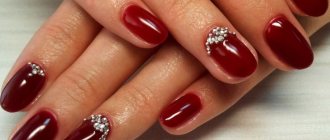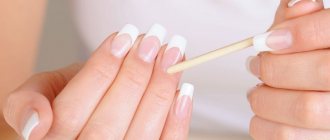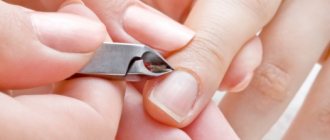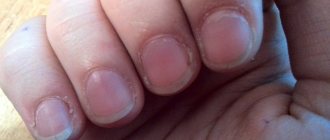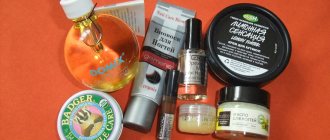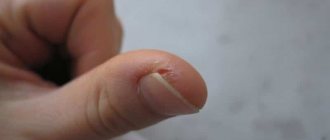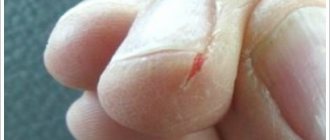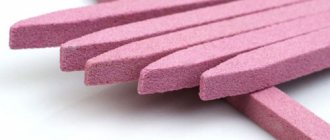From this article you will learn:
- What is a European manicure?
- What types of European manicure exist?
- What are the advantages and disadvantages of European manicure?
- What is the difference between classic and European manicure
- How to do a European manicure in a beauty salon
Psychologists have long proven that the first thing the interlocutor pays attention to is the smile, eyes and hands. It does not matter with whom the communication takes place - a man or a woman, a teenager or an adult. It is necessary to regularly monitor the condition of your nails and skin, especially since sometimes you don’t even need to go to a salon and spend money. The procedures can be carried out at home by finding all the information on the Internet. There are many options, but the most practiced and popular of them is European manicure. It does not harm the nail plate and skin, and also does not require special skills in the beauty industry.
Recommended articles on this topic:
- Manicure options for long and short nails
- Manicure for long nails: interesting ideas, fashion trends and rules of creation
- Manicure ideas for beginners: options, photos, step-by-step instructions
What is a European manicure?
European manicure is a nail care technique that does not involve the use of cutting metal tools. That is why it is so in demand these days among women and men. The so-called unedged European manicure was invented by French specialists. He immediately gained wide popularity due to the absence of unpleasant pain during the procedure.
This technique can be used by everyone, because it guarantees safety, no risk of blood poisoning, painless and pleasant care for the nail plates and skin of the hands. This procedure puts human health at the forefront.
The inventor of the European unedged manicure is considered to be Miss Marlene, a native of France who breathed life into the nail care industry back in the 1920s. Then only a few knew about this technique, but since the 80s of the last century it has conquered not only France, but the whole world. Below are photos of a European manicure. Please note: no sharp instruments!
The European manicure technique involves working not only with nails, but also with the skin, making hands more well-groomed, soft and beautiful. To do this, the cuticle is carefully moved to create space for applying the coating to the entire nail. As already mentioned, this procedure does not involve the use of any sharp instruments. An exception may be tweezers to remove excess skin particles around the nail. This means the absence of pain, discomfort and other unpleasant moments associated with other types of manicure.
Today, there are dry unedged European manicure (this method does not involve the use of any baths) and wet (an integral part of the process is a pleasant bath in which various strengthening agents are diluted). However, it is worth noting: before using the dry technique, you need to pay attention to the nail plates. If your nails are splitting, you need to either put them in order or turn to the second method of carrying out this procedure.
Professional unedged manicure
There are a large number of beauty salons, but despite this, the technique of performing European manicure is practically the same.
Technology:
- Initially, the master asks the client the desired method of softening the cuticle; a remover is often used.
- The master applies a disinfectant to his hands and the client’s hands.
- Using a cotton pad and without acetone liquid, remove the old coating from each nail.
- Using various files, the shape of the nail plate is corrected. If the nails are too long, at the client's request, they are trimmed with scissors. Filing a large section of the nail plate can lead to delamination.
- Next, a cuticle softening agent is applied to the cuticle. This occurs in the case of a dry type. The remover remains on the skin around the nail for two minutes, during which time the dead skin cells are broken down.
- If another technique was chosen, the master prepares a bath with a special product or puts gloves on the client. The procedure lasts about ten minutes.
- Use an orange stick or pumice to remove the cuticle. Pumice is used when the cuticle is thick.
- The remaining droplets of product and skin are wiped off with a damp towel.
- Apply the oil to the skin around the nails.
- Using massage movements, a nourishing cream is rubbed into the skin of the client’s hands.
- Finally, the specialist adds shine to the nails using a polisher.
People with thin cuticles can see results after the first application of a European manicure.
Main types of European manicure
Today the following types of European manicure are offered on the service market:
- Hot or wet. It is carried out to restore unhealthy and weak nail plates. For this purpose, baths with the addition of strengthening agents are used. With the help of such care, a leathery roller is painlessly removed with a special tool. There is no need to treat your nail with lotion, which can damage it.
- Dry. As already mentioned, with a dry European manicure no water procedures are used. In this process, the leathery ridges are removed, and a special strengthening agent is applied to the nail plates.
- Brazilian spa manicure. The methodology is similar to the previous type of procedure, however, moisturizing and mineral-rich products are additionally applied to the nail plates using gloves. This is a kind of nail bath that takes about 10–15 minutes. This method is practical, saves time for the master and the client, as it combines skin and nail care and, accordingly, a beautiful manicure.
- Combined European manicure, as the name suggests, combines the above methods. It is used in cases with rough and deformed skin around the nail plate. This type of European manicure differs from the classic one solely in the technology of nail treatment, since the use of sharp instruments when working with skin is allowed.
- Hardware classic European manicure is one of the varieties of dry manicure, and it is not difficult to do it yourself at home. Special attachments attached to the grinding apparatus help to work with nail plates. They carefully remove skin ridges and smooth out nails, as well as remove dead skin particles.
European combined manicure
- This type of manicure care is also called mixed. It will be offered to a woman if it is impossible to do only a European manicure and she needs to remove some defect with the help of nippers. Thin and dry skin is not cut, and burrs will have to be removed using a metal tool
- This combination can be made using the “wet” or “dry” method. At the end of the mixed manicure, nail design is performed. European combined manicure is an individual approach and maximum efficiency
Advantages and disadvantages of European manicure
Advantages of European manicure:
- No risk of infection, pain or discomfort. It is worth remembering that the master does not use sharp tools. This is a very important factor for those who have thin skin that is unable to protect the vascular system when damaged. In addition, the nail plate is not subject to deformation.
- Skin ridges are also removed from the nail plate, as with a classic manicure, only in this case, not sharp tweezers are used, but special cosmetics that weaken the skin structure and allow it to be removed completely painlessly.
- No discomfort during work. You can just sit and enjoy pleasant baths and treatment of nail plates without worrying about your hands.
- The procedure can be performed before nail extensions.
However, this technique also has its disadvantages. When using it for the first time, a combined version is used, which, as already mentioned, involves treating the skin with sharp instruments. In addition, the visible result of the procedure appears only after 4–5 months of regular use of this technique. Among other things, this method requires greater financial costs than other methods of nail care. But how does European manicure differ from classic manicure?
European manicure: tips and reviews
Easy, pleasant, a real helper for a woman - all this is said in reviews about European manicure. The advice of many ladies suggests that all girls should switch to such an unedged manicure, because it is safe care.
Many women regret that they did not switch to the European manicure technique earlier. After all, constant injury to the cuticle and its cutting does not add health to the nails and skin of the hands. Only careful treatment will help make the nail plate and skin healthy and beautiful.
If you are still in doubt about whether to give up classic care or not, do just one session of a European manicure and all doubts will immediately disappear. Feel the pleasant sensations and appreciate the excellent guaranteed results!
Classic and European manicure: what is the difference
Classic manicure is a hand care in which the cuticle is completely removed using nail tweezers or scissors, and the ptyregium (film from under the cuticle) is cleaned. This method requires the master to be extremely careful and professional, because sharp instruments can cause cuts. In addition, careless work in the process of removing the cuticle is fraught with the formation of burrs, which sometimes leads to blood contamination with dangerous bacteria or the appearance of ulcers. Among other things, when the skin is regularly removed, it gradually becomes harder and deforms the surface of the nail plate.
This is exactly what distinguishes European manicure from classic manicure.
What is European manicure and how does it differ from classic manicure?
The technology for performing European manicure has been developed relatively recently. Having tried a new approach to caring for hands, nails and cuticles, everyone notes its safety and convenience. European unedged manicure has long crossed the borders of Western countries, attracting the interest of residents of the USA and Asian countries. This is due to the fact that the technology for its implementation does not imply the use of forceps, scissors or other piercing and cutting tools.
Returning to history, it is worth noting that ancient Egyptian beauties took care of their cuticles using an infusion of medicinal henna. It was in Ancient Egypt that unedged manicure arose. We can assume that from there he began to move around the world.
Historians say that in 1830, the French monarch Louis Philippe, who was suffering from a painful hangnail, had surgery to remove part of his cuticle. To prevent this from happening again, the ruler of France began to carefully monitor the condition of his nails, generously rubbing in various oils and overseas essences. This fashion was quickly picked up in nearby countries, and well-groomed hands became the calling card of the aristocracy.
France at the beginning of the 20th century is recognized as the birthplace of modern European unedged manicure. Juliette Marlene played an important role in popularizing this technology. She was the personal stylist of the legendary Marlene Dietrich, who constantly struggled with manicure. The actress had fragile and brittle nails and painfully thin and bleeding cuticles. Resourceful Juliet found a solution to these problems. She invented a special type of manicure that eliminates the use of scissors and tweezers. A little later, the whole world learned about this stellar method, renaming it “European manicure.”
A simple manicure is quite easy to do; no special effort is required. However, there is always a dangerous possibility of cutting or injuring the delicate epidermis, even if the procedure is performed by an experienced specialist.
That is why women perceived the appearance of unedged manicure as an ideal option, which does not require special skills and knowledge. Its technology is aimed at helping those with fragile, brittle nails that are prone to splitting. It is also perfect for those whose cuticles grow quickly. After all, the more often you cut it off, the faster it grows and necessitates a repeated visit to the beauty salon.
How to do a European manicure in a beauty salon
Read material on the topic: Manicure sets: choosing the best for home and salon
Manicurists are always expected to be extremely careful and efficient, because visitors to beauty salons are aimed at the highest quality and beautiful effect. Let's look at the technology for performing European manicure step by step:
- First, both the master and the visitor must wash their hands or treat them with an antibacterial agent.
- Then the nail plates are cleaned of the varnish remaining after the previous manicure with an organic solvent.
- Next, the outer surface of the nail plates is leveled. Since European manicure does not involve working with sharp instruments, nail files of the required hardness are used.
- Leather rollers are treated with a special composition that weakens and prevents their rapid recovery. The components of such products are, as a rule, minerals and other beneficial substances that ensure healthy and smooth skin.
- When using the wet technique of European manicure, this step involves making a warm bath for the nails. It is important to note: the dry method provides higher durability of the European manicure coating than the wet one.
- Using a wooden tool with a pointed tip, particles of leathery rollers are carefully removed. Also, during European manicure, special sponges are used so as not to deform the structure of the nail.
- A moisturizer is applied to the skin of the hands, and an oily care liquid is applied to the leathery rollers.
- The nail plates are leveled using nail files. At the client's request, varnish or a strengthening agent is applied to the surface of the nails.
The European manicure procedure lasts only about half an hour. The effect is neat and well-groomed hands without any health risks. Of course, the technique is as harmless as possible, but you need to contact only a professional. An inexperienced master can deform the surface of the nail plate and reduce the positive effect to “no”.
The video is presented at the link:
How to do a European manicure?
The origin of unedged manicure
European manicure has many millions of fans around the world. This technique is loved not only by girls, but also by men who are accustomed to monitoring the condition of their hands and nails. The unedged technique first appeared in France, which is why European manicure is sometimes called French.
European manicure is suitable for everyone, without exception, and for people who have close capillaries or thin skin on their hands, experts recommend using only French manicure.
Miss Marlene is the woman thanks to whom the technology of performing European manicure began to gain popularity. Since the first half of the twentieth century, it became known to a small circle of people, and several decades ago this type of manicure began to gain increasing popularity, first in Western countries, and a little later throughout the planet.
How much does a European manicure and alternative procedures cost in beauty salons?
What is the price of a European manicure? It is difficult to answer this question unambiguously, since the final cost depends on the following factors:
- type of procedure;
- beauty salon class;
- professionalism of the specialist;
- price of consumables for a specific type of manicure;
- cost of specialist services;
- duration of the procedure;
- period of materials consumption;
- result of the procedure.
In addition, it is important to remember about the tools and compositions purchased by the beauty salon at its own expense. For European manicure the following can be used:
- Compositions for moisturizing leathery rollers. Such substances are usually mixed with water to subsequently soften the stratum corneum of the skin.
- Compositions for destroying bacteria on the skin of the hands of a specialist and a visitor to a beauty salon.
- Strengthening oily compositions for the nail plate and leathery ridges - used at the final stage of work.
- Soaking compositions for leather rollers for further removal of excess skin.
The Internet resource “SPR” provides statistical data on the cost of various types of services, calculated on the basis of data for the regions of Russia, including prices for European manicures. So the cost of a classic manicure varies in the range of 140-990 rubles. The average price in the country, calculated on the basis of 123 proposals, is 565 rubles.
The procedure for artificially increasing the length of the nail plate will cost more:
- Acrylic extensions: 800–2000 rubles (the average cost, calculated on the basis of 36 proposals, is 1400 rubles).
- Gel extensions using tips: 750–2000 rubles (the average in Russia is 1375 rubles).
- Gel nail extensions with forms: 850–2500 rubles (on average - 1675 rubles).
One of the types of European manicure - coating natural plates with gel polish - has a lower price than artificially increasing the length of nails. The price across the country varies from 300 to 1270 rubles (average 785 rubles).
Beauty salons in the Northern capital offer the following prices for nail care services:
- Manicure procedures (depending on the type of service) - within 400 rubles.
- Artificially increasing the length of the nail plate will cost 1,300–3,000 rubles.
- Nail design, depending on the chosen materials, will cost 50–500 rubles.
In Moscow beauty salons, the most popular service is coating nails with shellac. This manicure is chosen not only by the fair sex, but also by men and children.
Prices for such procedures in Moscow:
- Classic - 450–550 rubles.
- European manicure - 500–600 rubles.
- Hardware manicure—650-750 rubles.
- Japanese (health) manicure - from 1200 rubles.
Prices for manicures in Ekaterinburg beauty salons are lower than in the capital:
- decorative coating - 200 rubles;
- French manicure - 300 rubles;
- “mirror” effect - 300 rubles;
- biogel - 1500–2000 rubles;
- shellac - 1200–1700 rubles.
Based on data from the SPR website, we can conclude that the cost of manicure services in our country is low. More expensive types of procedures, in contrast to cheaper ones, have their advantages: durability (up to 30 days) and reliability (high quality, guaranteeing strong and beautiful nails). Thanks to European manicure, you can forget about fragile and weakened nail plates and enjoy your soft, neat, graceful hands. This effect can be achieved through the use of natural compounds that nourish both nails and skin. European manicure is one of the safest and simplest procedures of this kind, which can be performed either in a beauty salon by a professional or at home.
Features of files for European manicure
The technology for performing European manicure involves the use of special files, slightly different from the usual files we are used to, which correct the shape and length of the nail plate in a classic manicure. The principle and essence of the tool’s operation are the same, the only differences are in the design features. Since the treatment is not keratinized tissue, but soft tissue, the effect should be as gentle and safe as possible.
The materials from which files for unedged manicure are made are especially flexible and elastic. Thanks to these qualities, they do not injure the skin and do not cause bleeding wounds. Most manufacturers are constantly improving the design of manicure tools and the composition of consumables, seeking to simplify the process of removing cuticles and increasing the degree of safety of their use. The modern market offers a variety of nail files: laser, crystal, diamond-coated, etc.
According to the technology of performing European manicure, hands are pre-steamed. The instrument used for manipulation must be dry. First, the file is applied completely with its entire plane to the cuticle and filing movements begin. You can direct the nail file in different ways without fear of damaging the skin. It is absolutely safe due to its special structure, similar to a honeycomb.
What you need to do a European manicure at home
Learning and applying the European manicure method in practice is not difficult. It is not always possible to visit a specialist. Why not try yourself in such painstaking but skillful work?
To start working with nail plates, you need to buy a set for a European manicure, consisting of special devices and substances for caring for the skin and nails. You will need:
- tool for grinding and polishing nails;
- volumetric rectangular file with surface hardness 180–240 grit;
- pleasant to the touch rag napkin;
- composition for removing cuticles (solution or gel);
- moisturizing composition with minerals and other beneficial elements;
- special composition for leveling the surface of the nail layer;
- recessed container;
- solution for removing residual varnish;
- wooden tool for removing leathery rollers.
You can remove leathery ridges from the nail plate using a wide range of special products. A well-chosen substance for European manicure is the key to beautiful, well-groomed, gentle hands.
When carrying out the procedure yourself, it is worth using formulations with a thick consistency, as they hold their shape, are easy to use and adhere well to the skin.
Read material on the topic: How long should nails be: the secret to an attractive manicure
Gels are divided into 3 groups depending on the components of the substance:
- Acid gel - used in beauty salons, it dissolves and separates leathery ridges from the nail plate. The substance contains potent elements. If you handle the product carelessly, it can cause harm to the skin.
- Alkaline - contains gentle elements. Suitable for independent work with European manicure. The main disadvantage of this product is its slow adhesion to the skin (about half an hour is required).
- Fruity - dissolves and separates leathery rollers, and also nourishes the nail plate and skin with beneficial minerals. This is a great option for doing a European manicure yourself.
Step-by-step instruction
The technique for performing an unedged manicure is very simple. You will need a minimum set of tools and special cosmetics to do a manicure at home:
- nail file;
- nail scissors;
- scissors or rounded scissors;
- nail file or buff for polishing;
- nourishing oil and cuticle remover (oil, gel, cream);
- hand cream.
After studying the instructions on how to do an unedged manicure at home, you can easily do it yourself. The video at the end of the article will help you visually consolidate your knowledge.
Step 1. Preparatory phase
So, an unedged manicure begins step by step with the stage at which you have to clean your nails and steam the skin of your hands. Use nail polish remover to remove the old coating. Nails must be perfectly clean.
If you want to try an unedged wet manicure, we will give you one piece of advice. You can replace lotions and oils at home with lemon juice. Acidic water softens the cuticle very well. If your choice is a hot bath, then instead of special cosmetics, try olive oil.
Have you decided to give yourself a dry, unedged manicure? Skip this point and watch an interesting video lesson. The video clearly demonstrates the technique of performing a manicure without preliminary steaming.
Step 2. Length and shape of nails
For substantial trimming of nails, use nail scissors. Using a file, give the free edge the desired shape. To prevent your nails from peeling, follow three rules.
- File the ends only in one direction that is convenient for you.
- During the procedure, nails must be dry. Therefore, if you decide to use a wet or hot type of manicure, adjust the shape of the free edge in advance or thoroughly dry the nail plate after the bath.
- How to properly file nails? Hold the file perpendicular to the free edge, i.e. at an angle of 90°, as in the photo.
Step 3. Working with the cuticle
In a European manicure, to soften the cuticle, you can use cosmetics that contain lactic and fruit acids:
- vitamin cream;
- gel (oil) to soften or remove cuticles.
Apply the product to the skin around, but without getting on the nail itself, and leave for 1-3 minutes. The holding time should be adjusted depending on the manufacturer's recommendations.
Next, using an orange stick or a metal spatula (if the skin is rough), you can push the cuticle to the base of the nail plate or clean it off, as shown in the photo. The second option will be possible only if you have very thin skin, or you do a European unedged manicure 5-7 times in a row. The side rollers are cleaned in the same way.
Step 4. Moisturize and nourish
An important point is to moisturize the skin around the nail plate. Cosmetic oil is applied to the cuticle and side ridges. The product not only soothes irritated areas, but also has an antibacterial effect. Don't forget about the skin of your hands, which also needs your care. Apply moisturizer and treat yourself to a relaxing massage.
Step 5. Final touch
Finally, you can polish your nails with a special nail file or buff. This will give them a healthy shine, as in the photo.
If desired, apply a base or decorative coat after degreasing your nails with nail polish remover.
Now you know how to do a European manicure. To consolidate the knowledge gained, we invite you to watch the video. After all, it is better to see once than to read 100 times. Elena will tell you in detail how to do a wet unedged manicure at home. The technique is extremely simple; you will not have any difficulties in giving your nails the perfect appearance.
Tools for high-quality classic and European manicure
The result of a European manicure depends not only on the professionalism of the master, but also on the materials. It is better to buy expensive products and kits from famous brands. A professional in his field, working only with reliable and proven materials, will be able to create the perfect European manicure.
The main reason for the advisability of purchasing expensive manicure tools is the materials from which they are made. Trusted brands make their products from high-quality metals that do not rust over time, which ensures the sterility of the instruments. A low price usually means low-quality material, working with which carries the risk of harmful bacteria and microorganisms entering the blood and skin.
On sale you can find the following special tools for European manicure:
- Wire cutters. Such a device can be intended either for the hands or for the feet (for both cases the size and parameters of the tip are different). Nippers are needed to cut off the excess part of the nail plate. It is important to ensure that they do not become dull, as the healthy structure of the nail depends on this. It is easy to check a tool: when there is a clicking sound when using it, this indicates the proper level of manufacture. In addition, it is important to inspect the reliability of the fastenings. Stainless steel material is used in the production of this device, which makes it an excellent option for working with European manicure techniques.
- Scissors. A high-quality device of this type is characterized by measured sliding, accurate and precise cutting and stable joints between the blades. To test the scissors, you can simply make a couple of movements with them on the nail plate. The cut should be without jagged edges, and the work itself should be easy and confident.
- File. Today on sale you can see a huge assortment of this instrument (as they say, for every taste and color). There are nail files made of steel, baked clay, and plastic. To get a high-quality European manicure, you should take this device seriously. The best tools are those with diamond coating, which are harmless to the nail structure and easy to use.
- Scraper. It is a device that has two working surfaces on different sides, designed for processing and removing leathery rollers. It is important to purchase a tool made of stainless metal with an uneven surface to help you hold the device firmly. Proper handling of a scraper is the key to a beautiful European manicure.
- Knipsers. Miniature tweezers designed for safe nail care. With their help, you can easily cut off any piece of an overgrown nail plate without touching the delicate skin. It is important that the material contains solid substances that allow you to do a European manicure without the risk of causing cuts.
- Gels. An integral part of the European unedged manicure procedure. The advantage of these compositions is that there is no need to use oily liquids and moisturizers when working with the skin. The gel itself nourishes the skin and eliminates the risk of cuts and unevenness on the surface of the skin.
Difference from classic manicure
As mentioned above, European manicure does not involve the use of cutting tools. This is the complete opposite of classic trimming, which uses sharp nippers or scissors. Despite the popularity of this treatment, the latter has serious drawbacks.
For example, when cuticles are cut carelessly, painful hangnails appear. This is not only unaesthetic, but also dangerous. Such injured areas of the skin open the green light to infections.
And some ladies note that with regular classic manicure, the cuticle becomes rougher and grows faster.
An unedged manicure is devoid of the above-described disadvantages.
Technology for performing European manicure at home
The European manicure procedure is not carried out on moistened skin, so it is necessary to dry your hands with a soft towel after taking a bath or applying a nourishing cream with vitamins and minerals. In addition, it is worth waiting for some time, and only after that starting the European manicure procedure. So, the step-by-step method of work is as follows:
1.Preparing the nail plate.
Professionals advise starting this step a few hours before the European manicure procedure itself, which gives the nail plates and skin the opportunity to “breathe.” Of course, the previous coating must be completely removed. To do this, you will need a special product that does not contain vinegar components and cotton pads.
The most difficult thing at this stage is to remove the shellac. This requires at least a dozen cotton pads, a dozen pieces of foil and a means for erasing the varnish layer. It is necessary to dip the sponge and hold it on the nail plate for a quarter of an hour using metallic paper. Then carefully remove the materials and remove the removed shellac with a special tool. Remove remaining particles using a product that does not contain an acetic component. Only after this can you begin the European manicure.
2.Softening and removing the cuticle.
Nail baths can be done before a European manicure, or simply every day to care for the nail plates: the skin becomes soft and silky, and the nails become beautiful and healthy. Using a brush, apply an oily liquid that stays on the nail plates for 3-5 minutes. After this, the liquid should be smoothly and carefully rubbed into the skin and nails. This is the most important step in working with European manicure. Technology for removing leathery rollers:
- The nail is treated with a special product.
- The composition stays on the nail plate for about a minute.
- The gel is carefully washed off using a soft paper handkerchief.
- Using a special tool, the remaining skin particles are removed, the leathery roller is moved, revealing the surface of the nail plate. When performing a hardware European manicure, it is necessary to use a special device - a small brush.
Giving the nail the required length and shape.
The file will help adjust the structure of the nail plate. To remove excess skin particles, you need to use a special tool for leather rollers or a sanding machine. A buff, which has different grain sizes on its edges, will help make the surface smooth and even, which means it is great for European manicure. After working with tools, it is very important to treat your hands with a disinfectant and wipe them dry with a cotton towel.
Moisturizing and nourishing the skin.
The technique of creating a beautiful manicure is not complete without treating the skin and nail plates with special moisturizing compounds and products that fill the skin with vitamins and minerals. For European manicure, the main thing is health and beauty, which lies in simplicity and conciseness. You need to take care of your hands every day.
Application of base and decorative coating.
For high-quality and long-lasting results from a European manicure, it is very important to treat the nail plate with a colorless transparent varnish, which will nourish the nails with the necessary beneficial minerals, as well as protective components that ensure their healthy appearance.
Carefully and smoothly use a special brush to treat the nail plates with varnish. It is important that the nails are cleaned of excess skin particles, otherwise all the work will go down the drain.
Aerosol drying.
This is the final step in the European manicure procedure. How does it go? At a distance of fifteen centimeters from the nail plates, you must carefully apply a special substance with a spray.
A method for gently removing the skin around the nail with a cuticle softener
Not so long ago, our mothers and grandmothers actively used metal tools to care for their hands. When doing a manicure at home on your own or even in Soviet beauty salons, nails were cut only with scissors or clippers. The files were also exclusively metal.
In recent years, we have increasingly come across information that metal tools are harmful to nails. This is especially true for “problem” nails: damaged, dry, brittle, wavy, thin. Only highly abrasive files and special care products are suitable for caring for them. One of them is a cuticle remover.
Previously, this miracle of modern cosmetology could only be bought in a professional nail cosmetics store: CND, LCN, etc. Now quite affordable brands have begun to produce it: Malava, Sally Hansen, Orly, Smart Enamel, etc. And you can buy them at any perfume and cosmetic store.
Benefits of using the product:
Firstly, if you do a manicure yourself, then as a result of its use, your nails and cuticles look as well-groomed as after visiting a beauty salon.
Due to its gentle effect, the product helps to overcome problems such as hangnails.
The product does not injure the nail plate, unlike the crude option - removing the cuticle using cutting tools. Several similar experiments, even on healthy nails, can lead to injury to the growth part of the nail. As a result, problems such as waves, transverse and longitudinal grooves, cracks, etc. appear. Subsequently, in order to get rid of them, you need to completely change your home care tactics and allow the deformed nail plate to grow completely. And this may take from several months to six months.
Cuticle removers are usually based on fruit acids, which means they gently exfoliate dead skin cells without affecting the deeper layers. As a result of exposure to such cosmetics, only what should be removed is removed. A prerequisite for this must be strict adherence to the instructions and exposure time of the cream (gel, lotion, etc.).
Gentle cuticle removers are suitable for men's manicures. Everyone knows that it is more difficult for men to trust someone with their body, especially if the procedures can be traumatic. This is due to the peculiarities of male psychology, which modern cosmetologists have studied far and wide and offer men only unedged (European) manicures. Therefore, if you want to give your man a manicure, it will be easier for you to persuade him to undergo safe, gentle procedures.
To gently remove cuticles (in addition to the product itself), you will need:
- Hand bath (a deep glass bowl will do) with the addition of sea salt (2-3 tablespoons per 1 liter of water);
- Orange stick;
- Several cotton pads.
Since we carry out the procedure ourselves, we need to treat our hands one at a time. Apply a thick layer to each finger over the entire cuticle area and give the cuticle remover a little time to work. To do this, immerse the tips of all your fingers in salt water for 2 - 3 minutes. Then start treating with those fingers on which the cuticle is less grown and dry, gradually moving on to the more problematic ones. As a rule, from the little finger to the thumb. When you take your finger out of the water after a few minutes (but no more than 5), you will find that the cuticle is loosened and softened. It is very soft and easily separates from the elastic, healthy skin around the nail. Using an orange stick, gently push back the cuticle. Do not press too hard on the nail plate, because it has also become much softer and more vulnerable from exposure to salt water. Wipe the dead skin and excess product onto a cotton pad and do the same with the next finger. At the end of this manicure, wash your hands with warm water and soap and rub any nourishing oil into the nail plates and cuticles.
If you want to apply color, let your nails dry. The varnish should be applied no earlier than 15-20 minutes after water procedures. If you do this earlier, the nail plate will be wet and swollen. This is very useful for the health of nails, but not for polish! Over time, it will, of course, dry out under a layer of varnish, but the latter will most likely crack, no matter how high-quality it is. Before applying varnish, the nail plate should also be “degreased”. This can be done either using a nail polish remover without adding oils (these are very rare on the market) or using a special alcohol-containing composition.
Cuticle remover allows you to significantly reduce the time of home cuticle care!
Secrets that will help you enjoy a beautiful European manicure longer
All representatives of the fair sex want their manicure to remain as attractive for a long time as on the day of the procedure.
A European manicure can look great in 3-4 weeks if you follow all the recommendations of professionals:
- It is very important to apply a base coat to the nail plate. This will ensure greater durability of the gel polish.
- During wear, the color coating may peel off. Do not apply more than two layers of varnish. Be sure to dry the first coat thoroughly before applying the second.
- The varnish completely dries after twelve hours, and therefore you should set aside a day to carry out the full procedure (preferably a weekend).
- A smooth finish with a European manicure is ensured by carefully removing excess particles of the nail and skin.
- It is very important to take the choice of a grinder or file seriously, but the main thing is not to overdo it, as you can injure the skin or deform the nail plate, ruining the final result of the procedure.
- The varnish coating must contain a quick drying component. Such compositions have a very high level of durability.
- The effectiveness of the procedure largely depends on the protein component in the products used. It nourishes the nail plate with useful minerals.
- Nails often become brittle due to the use of cheap devices in European manicure, which increase the risk of injury and roughly treat the skin and nail plates.
- To gently remove excess skin particles and ensure the safety of the European manicure procedure, use a special sponge.
- Do not shake the container with the varnish coating, as air appears in the liquid, which deforms the nail plate when applying the product.
- If you do a European manicure yourself, do not steam your hands in the bath. This can lead to nail deformation when applying the product.
How to switch to an unedged manicure
Many women, having heard about the benefits of unedged manicure, immediately want to switch to it, but they don’t know how to do it correctly, how much time and effort it takes. There are no specific general parameters; the process is very individual. Girls whose cuticles grow slowly may notice visible results already from the second procedure. Those who are less fortunate need to be patient and wait 5-7 sessions to understand that they chose a European manicure for a reason. In any case, if you follow all the recommendations of the master, the effect will not take long to appear.
If you decide to switch from a classic to an unedged manicure, be prepared to start preparing the skin of your hands and nails for this process in advance. Systematically treat them with essences, emulsions and nourishing, dense creams with a high glycerin content. It is this that helps retain moisture inside the cells, preventing it from evaporating. During the transition, you should be prepared that at first you will still need tweezers and scissors from your usual manicure set to remove dry skin or hangnails.
Where to buy everything you need for a European manicure
- “MIR FILOK” – own production of nail files.
- "WORLD OF FILES" is the main supplier!
- The showroom is located in Moscow.
- Delivery throughout our vast Motherland!
Why is “WORLD OF FILES” the best option for purchasing a product for you?
- Our store is built on our own production of saws. Thanks to this, you get: minimized cost of service, tested and confirmed product quality, fast production, attractive conditions for distributors.
- Our nail file is made only from materials that have repeatedly proven their quality (South Korea).
- Wide variety of product. Thus, a manicurist with any level of professionalism will be able to satisfy his interests.
- You can figure out which file is right for you. We carry out individual orders.
- Another advantage is the application of your brand logo on the working surface of the files.
